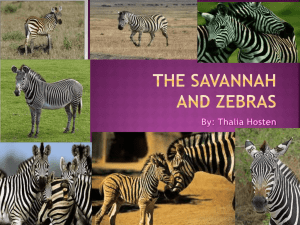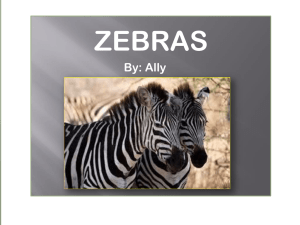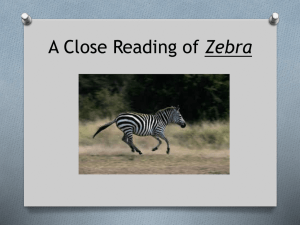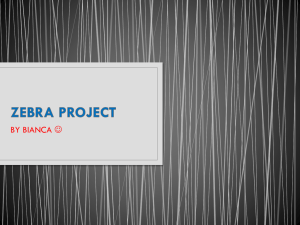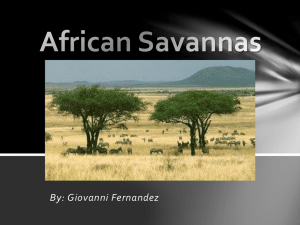Zebras - (includes glossary)
advertisement
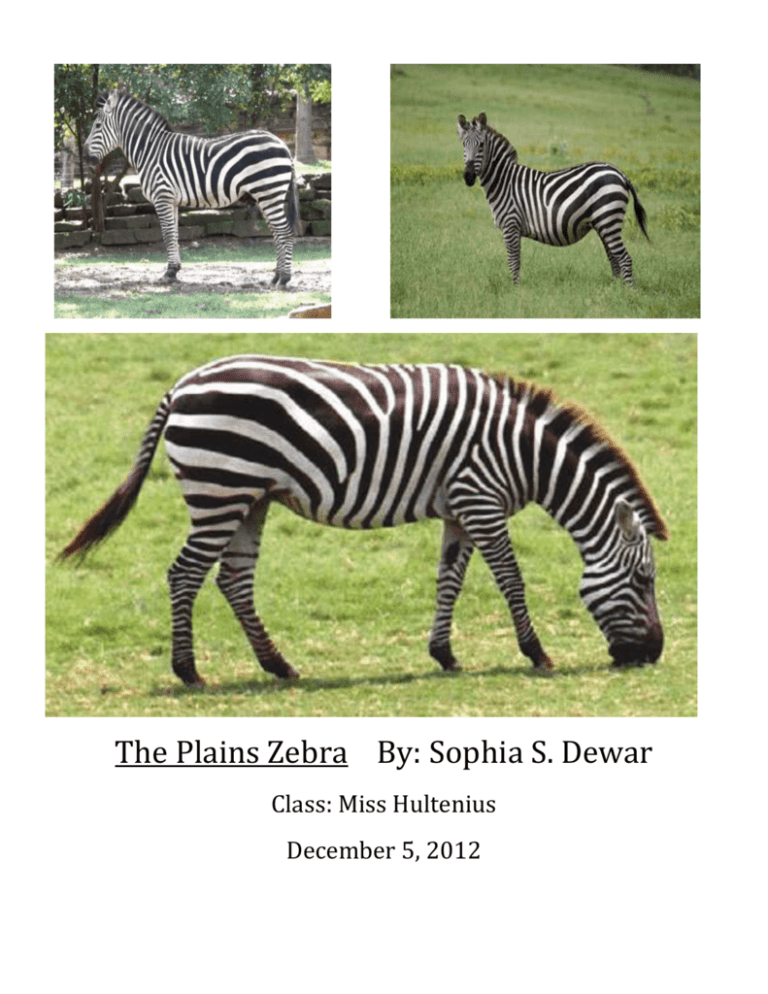
The Plains Zebra By: Sophia S. Dewar Class: Miss Hultenius December 5, 2012 Introduction Have you ever heard of a zebra? If you haven’t then you’re in for a very big treat. A zebra is a mammal and it is also a part of the horse family. The zebra mostly is expecting a life span of 20 years maximum because of its unique adaptations. Adaptations #1 Habitat The plains zebra has adapted well to life on the African Savanna, especially when trying to defend themselves from predators such as lions. # 2 Legs Zebras have very long, slender, and strong legs. With these legs it enables the zebra to run up to 40 miles per hour. The zebra is also nimble enough to evade predators. These legs have hooves at the bottom of each leg, now these hooves let the zebra kick their predator. This kick is able to injure or even kill a predator as big as a lion. #3 Teeth The plains zebra is an herbivore with a diet of thick grass and leaves from short trees. The plains zebra’s strong upper teeth and lower teeth are very special adaptations that help the plains zebra break down their food. The back teeth are designed for grinding their food. The front teeth are designed to pull the grass free from stalks. Zebras also make friends by grooming each other with their teeth. With these teeth they can also inflict powerful bites. #4 Stripes Each plains zebra has black or white stripes but each is a little different. As the zebras run it creates a little “blur” making it harder for a predator to attack an individual zebra. Another theory on why zebras have stripes is because it may help regulate the zebra’s body temperature. If the plains zebra didn’t have these adaptations they would probably die because they can’t defend themselves from predators such as lions. I’m just glad they are not an endangered species. Habitat Plains zebras are located in the south of Ethiopia, through East Africa, as far south as Angola, and parts of eastern South Africa. You can also find plains zebras in Southern and Eastern Africa. In countries such as Namibia, Zambia, Kenya, Tanzania, and in Mozambique. They can inhabit savannas, open woodlands, and forest areas. Appearance The plains zebra is mid-sized, has a thick body, and short legs compared to the other two zebras. The adults both female and male can stand 3.6 to 4.8 feet tall. They can also be 6.6 to 8.2 feet long. Adding to that they can have an 18 to 20 inch tail. The adult plains zebras can weigh 390 to 850 pounds. The males are usually 10% heavier then the female zebras. The plains zebra will mostly have a Y shape in stripes in the midsection of its body. Between the dark, solid stripes are beautiful shadow stripes. The mane begins at the forehead between their eye level and their ears, and it runs down to the end of their neck. The eyes of the plains zebra are on the sides of the zebra. This position helps the zebra see predators in all directions all at one time. Diet The plains zebra eats leaves, shoots, shrubs, herbs, twigs, and a little bit of flowering plants, but most of all the plains zebra grazes on grass. The plains zebra eats 92% of grass, 5%herbs, and 2% shrubs. These animals are very nomadic moving from one watering hole to another. These zebras will usually be found only within 25-30 kilometers from a watering hole. Something Special Predators The plains zebra’s major predators are lions and spotted hyenas. The Nile crocodiles are also a great threat to these zebras during migratory river crossings. Some wild dogs, cheetahs, and leopards mostly focus on getting the foals. Olive Baboons also may prey on the foals but do no harm to the adults. The plains zebra mostly tries to outrun predators like lions and spotted hyenas, but otherwise they often just chase or scare smaller predators. Communication The plains zebra has six different calls. They make a high-pitched call when they want to contact the herd. When plains zebras see a predator they make a two-syllable alarm call. When zebras are content they will make a more drawn out snort. The males will make a short high-pitched squeal when they are hurt, and foals will emit a drawn out wail. When zebras greet each other their ears stick up and face forward. When threatened their ears go down. Senses The plains zebra has awesome eyesight. Believe it or not the plains zebra can see in color, it also has night vision. These zebras also have great hearing skills. They have large, round ears, and can actually turn their ears in about every direction. In addition plains zebras have an acute sense of taste and smell. Conclusion As you can see the plains zebra is a very interesting and fascinating creature. If the plains zebra did not have these incredible features it would probably die. At least these animals adapted and still exist. Glossary 1. Mammal – Warm blooded animal 2. Predators – Animals that can eat you 3. Slender – Skinny 4. Enables – Lets 5. Nimble – Quick 6. Evade – Get away from 7. Inflict – Give 8. Theory – Idea 9. Regulate – Control 10. Inhabit – Live in 11. Flowering – A blossom turning into a flower 12. Nomadic – Moving place to place 13. Contact – Communicate with 14. Content – Happy 15. Drawn-out – Long 16. Emit – Make a sound, or a sound coming out 17. Migratory – Move around 18. Wail – Cry 19. Features – Characteristics of an animal 20. Mane-The hair that goes down the neck of a horse or zebra 21. Communication-How they talk they can communicate 22. Camouflage-How it hides 23. Acute-very good 24. Stalks- stem Bibliography Websites #1. http://en.wikipedia.org/wiki/Plains_Zebra #2. http://www.ehow.com/info_8561920_threeadaptations-zebra.html #3. http://www.theanimalspot.com/plainszebra.htm #4. http://www.ehow.com/about_6321428_plainszebra.html #5. http://en.wikipedia.org/wiki/Zebras Books #1. ZEBRAS By: Lynn M. Stone (published 1990) #2. LARGE HERBIVORES By: Pat Morris and Amy-Jane Beer (published 2003)

